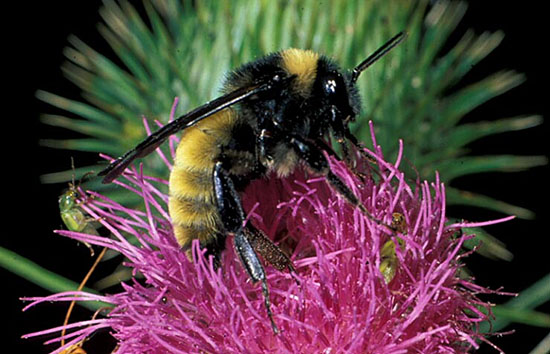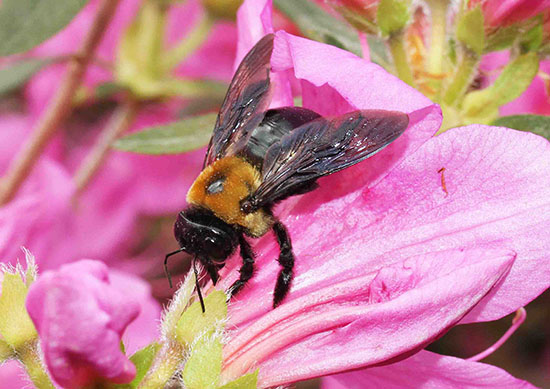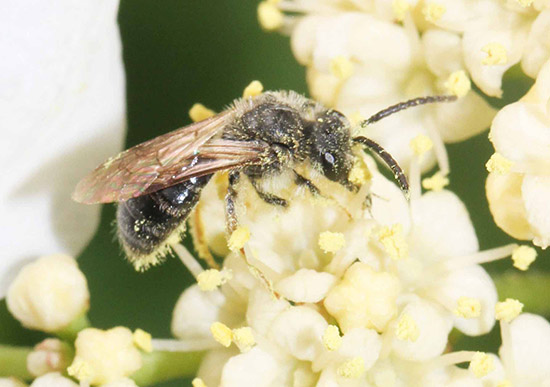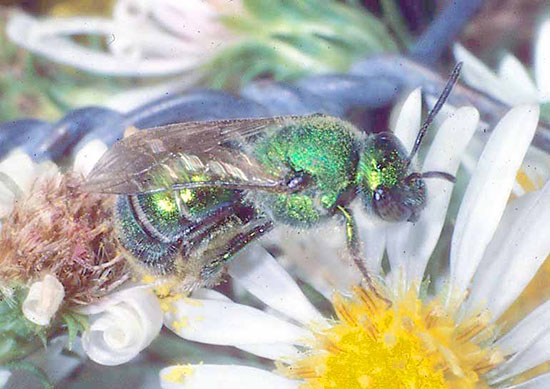Issue 9, June 26, 2017
Native Bees
National Pollinator Week was June 19-25, a good time to discuss bees. When you mention bees to most people images of golden-yellow honey bees come to mind. However, there is a lot more to bees than the exotic honey bee. In fact, there are over 20,000 bee species worldwide and around 500 species of bees native to Illinois.
Like honey bees, these bees are excellent pollinators that are sensitive to insecticide and fungicide applications. Their numbers have been reduced by diseases apparently introduced by human commerce from other areas of the world. Loss of habitat is also a concern. Tolerance of existing nests and augmentation of the old stems, wood, and bare soil areas many of these use to nest helps increase their numbers. They are generally more reluctant stingers than honey bees and wasps.
While honey bees live in colonies that can reach 60,000 individuals and bumble bees live in colonies that can reach 400 individuals most of our native bees (90%) are solitary bees. Unlike honey and bumble bees that have a division of labor where a queen lays eggs and her offspring perform jobs such as caring for young, foraging, etc., female solitary bees do all those jobs by themselves.
A female solitary bee will select a place to build her nest. Unlike honey bees that live in larger cavities (which is why we are able to keep them in hives) most (70%) of our solitary bees nest in the ground while others may nest in wood, hollow or pithy branches. Once she has selected a location, she will create nest cells. Inside of these cells she places a ball of pollen mixed with nectar and lays an egg on it. When the egg hatches, the larva will feed on the pollen ball. Generally, these bees will not emerge until the following year.
Some of the more common native bees in Illinois are:
Bumble bees – Bumble bees get their name due to the buzz they produce while collecting pollen (buzz pollination). They are social insects and colonies can have 50-400 individuals. At the end of summer, colonies will die off and mated queens will hibernate. They are cavity nesters, generally in abandoned underground rodent burrows, and are active from spring through late fall. They are robust bees that are hairy with yellow, black, white, brown or orange bands.

Bumblebee on thistle.
Eastern carpenter bee – Eastern carpenter bees are commonly considered pests because they often construct nests in wood of homes and other buildings (painting wood can prevent this). They are active from spring through fall. Due to their large size they primarily visit large and open-faced flowers. They look similar to bumble bees. However, the top of the abdomen of carpenter bees is bare, black and shiny.

Carpenter bee on azalea blossom.
Leafcutter bees –These bees cut pieces of leaves or petals to line the walls of their nests. They are solitary nesting and create their nests in pre-existing wood and other plant cavities. Leafcutter bees are active from early to late summer. They are medium to large bees, with smoky colored stout bodies with pale bands on their abdomen.

Leafcutter bee on viburnum.
Sweat bees - Many species are attracted to human sweat which they consume for the salt contained in it, thus their common name. Most sweat bees nest in the ground. Sweat bees can be found from spring through fall, with most species being active during the summer. They are small to medium sized bees and are often brightly colored and metallic with colors ranging from green to red and yellow.

Sweat bee adult.
Other native bees include yellowfaced bees, mason bees, small carpenter bees, longhorned bees, mining bees, cellophane bees, and squash bees. (Ken Johnson, Extension Educator – Horticulture)
Author:
Ken Johnson